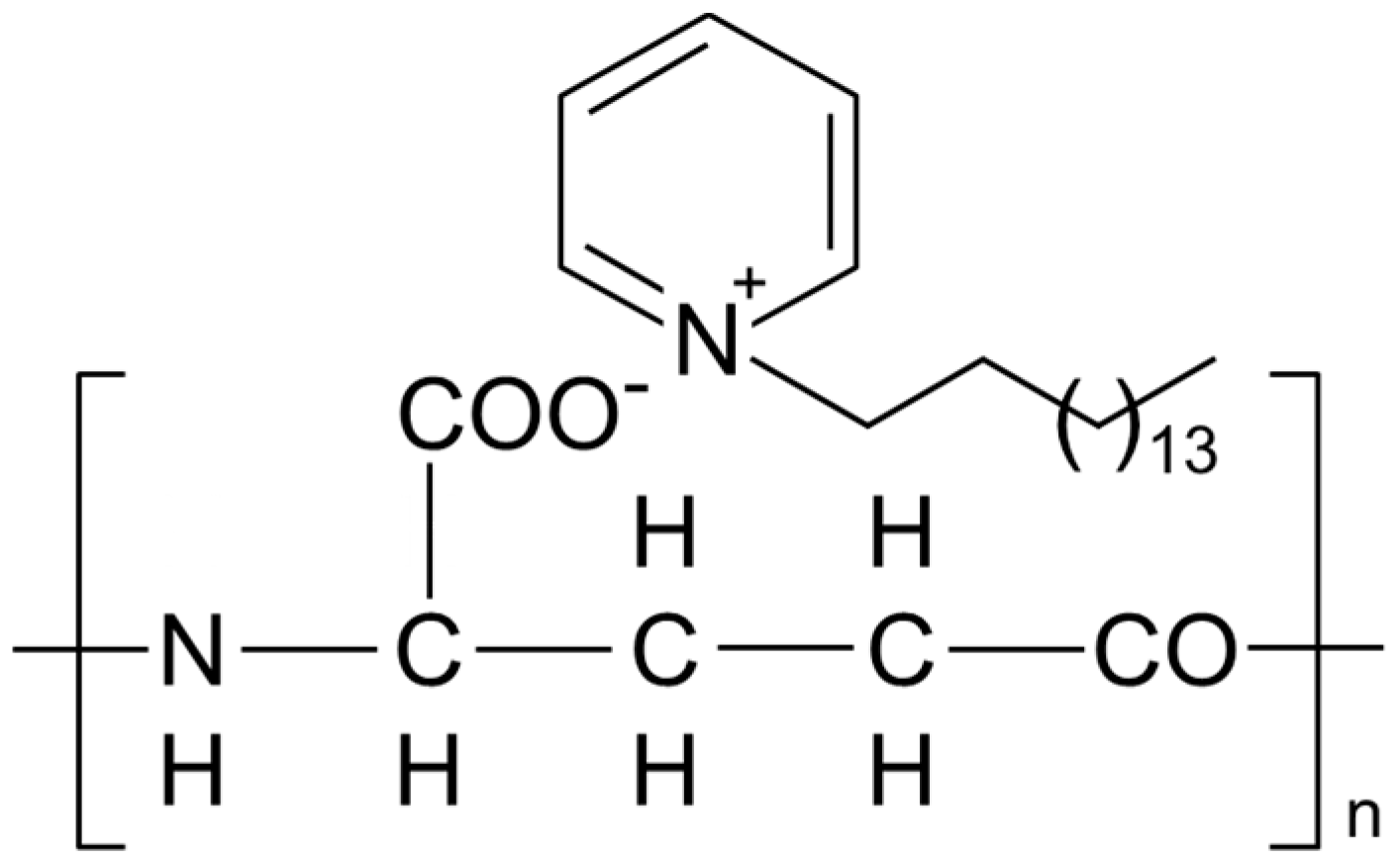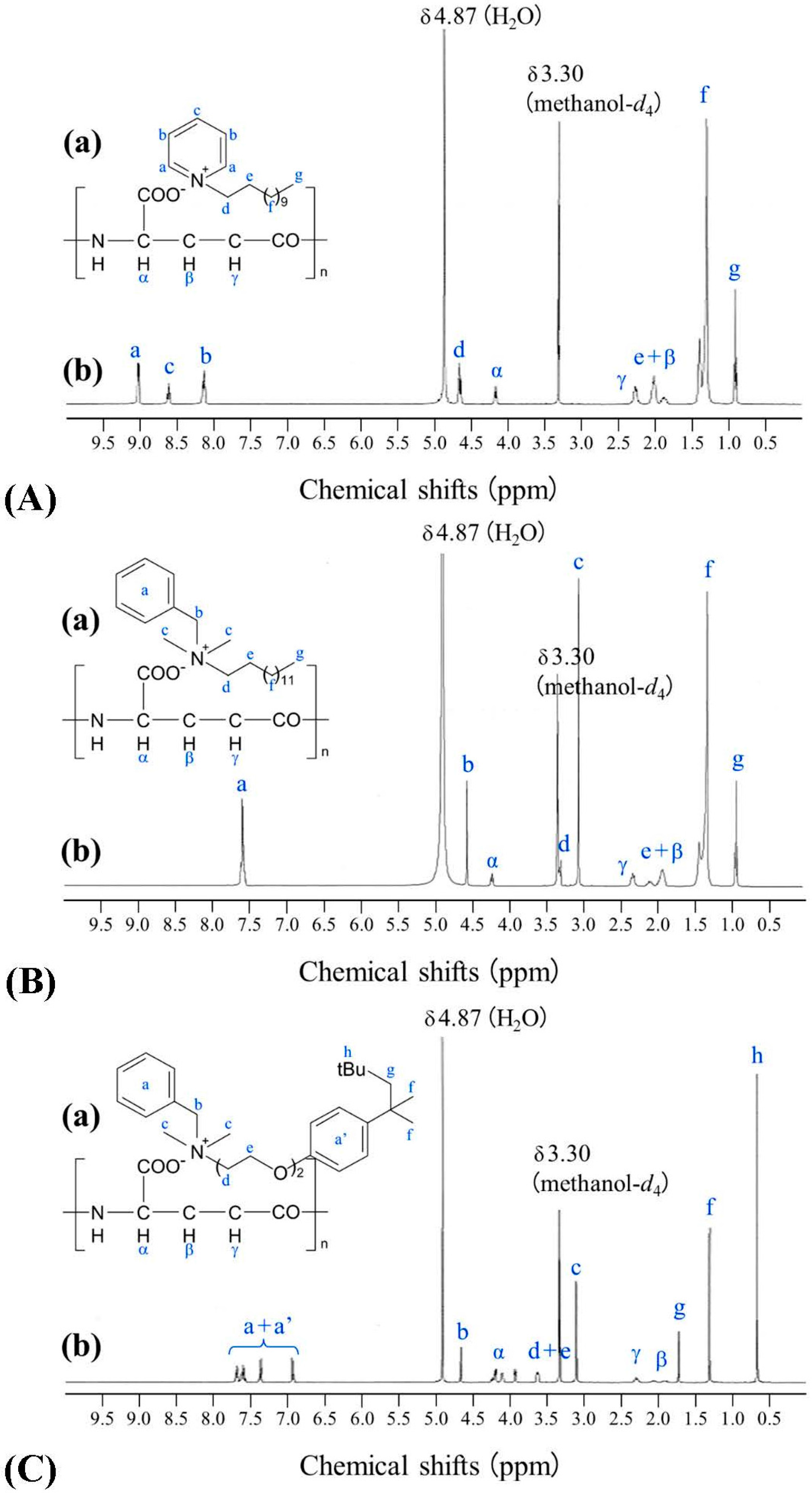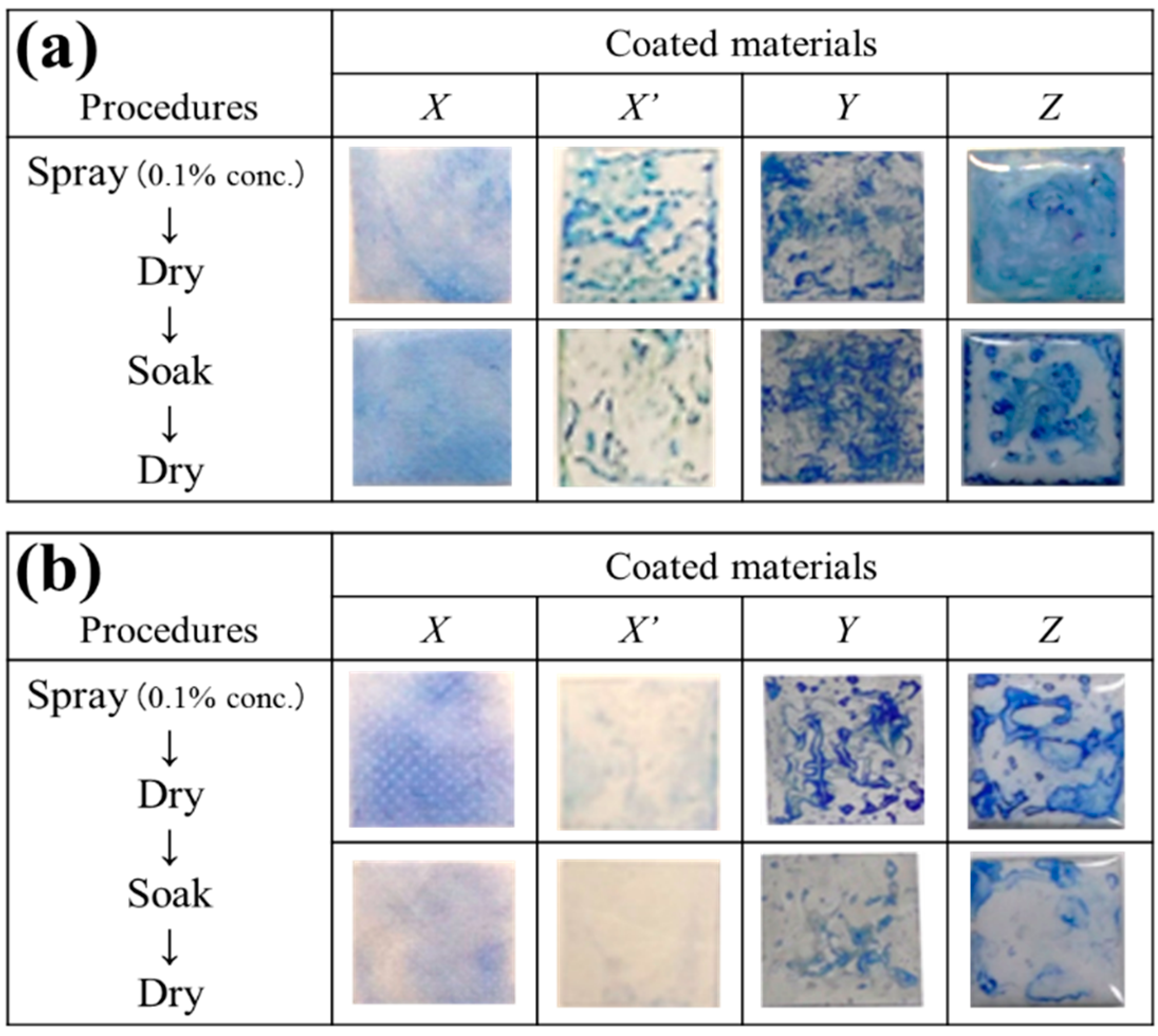Poly-γ-glutamate-based Materials for Multiple Infection Prophylaxis Possessing Versatile Coating Performance
Abstract
:1. Introduction

2. Results and Discussion
2.1. Synthesis and Structure of New Poly-γ-glutamate Ion-Complexes (PGAIC) Materials

2.2. Versatile Coating Performance of PGAICs
| (a) | Water-Soaking | Coating Materials | |||||||
| Base Materials | Treatment | PGA/HDP | HDP+ | PGA/DDP | DDP+ | PGA/BZA | BZA+ | PGA/BZT | BZT+ |
| PP disks | Before | + (1.0) | + (1.6) | + (5.8) | + (8.4) | + (5.4) | + (7.2) | + (4.8) | + (4.6) |
| After | + (1.2) | — | + (7.6) | — | + (7.0) | — | + (4.6) | — | |
| Stainless steel sheets | Before | + (1.8) | + (1.6) | + (5.0) | + (3.6) | + (3.6) | + (3.6) | + (4.2) | + (4.2) |
| After | + (1.6) | — | + (3.0) | — | + (2.4) | — | + (2.6) | — | |
| Bathroom tile sheets | Before | + (2.0) | + (1.6) | + (9.4) | + (3.6) | + (5.2) | + (3.6) | + (6.2) | + (4.2) |
| After | + (2.0) | — | + (7.6) | — | + (3.8) | — | + (4.2) | — | |
| (b) | Water-Soaking | Coating Materials | |||||||
| Base Materials | Treatment | PGA/HDP | HDP+ | PGA/DDP | DDP+ | PGA/BZA | BZA+ | PGA/BZT | BZT+ |
| PP disks | Before | + (0.1) | + (1.0) | — | — | + (0.2) | + (3.6) | + (1.2) | + (4.8) |
| After | + (0.3) | — | — | — | + (0.2) | — | + (1.4) | — | |
| Stainless steel sheets | Before | + (0.3) | + (<0.1) | — | — | + (0.1) | + (0.6) | + (0.1) | + (0.7) |
| After | + (0.3) | — | — | — | — | — | — | — | |
| Bathroom tile sheets | Before | + (0.4) | + (<0.1) | — | — | + (<0.1) | + (0.4) | + (0.9) | + (0.7) |
| After | + (0.4) | — | — | — | — | — | + (0.6) | — | |

| Tested Materials | |||||||||
|---|---|---|---|---|---|---|---|---|---|
| Microorganisms | PGA/HDP | HDP+ | PGA/DDP | DDP+ | PGA/BZA | BZA+ | PGA/BZT | BZT+ | QAS+ |
| Staphylococcus aureus | 4 | 2 | 48 | 24 | 8 | 8 | 64 | 64 | >200 |
| Escherichia coli | 100 | 64 | 200 | 128 | 100 | 100 | 100 | 100 | >500 |
| Pseudomonas aeruginosa | >500 | >500 | 100 | 64 | 400 | 400 | 200 | 200 | >500 |
| Candida albicans | 50 | 25 | 128 | 100 | 25 | 25 | 64 | 64 | >500 |
2.3. Anti-Influenza Activity of PGAIC


3. Experimental Section
3.1. Materials
3.2. 1H-Nuclear Magnetic Resonance (NMR) Spectroscopy
3.3. Gel Permeation Chromatography (GPC) Conditions for PGAICs
3.4. Rapid Coating of PGAIC on Material Surfaces
3.5. Bromophenol Blue (BPB) Staining
3.6. Antibacterial Assay
3.7. Antifungal Assay
3.8. Antiviral Assay
3.9. Cytotoxicity Test
3.10. Minimal Inhibition Concentration (MIC) Determination
4. Conclusions
Supplementary Materials
Acknowledgments
Author Contributions
Conflicts of Interest
References
- Ashiuchi, M.; Misono, H. Poly-γ-glutamic acid. In Biopolymers for Medical and Pharmaceutical Applications; Steinbüchel, A., Marchessault, R.H., Eds.; Wiley-VCH: Weinheim, Germany, 2005; Volume 2, pp. 827–878. [Google Scholar]
- Tanimoto, H.; Mori, M.; Motoki, K.; Torii, K.; Kadowaki, M.; Noguchi, T. Natto mucilage containing poly-γ-glutamic acid increases soluble calcium in the rat small intestine. Biosci. Biotechnol. Biochem. 2001, 65, 516–521. [Google Scholar] [CrossRef] [PubMed]
- Ashiuchi, M.; Fukushima, K.; Oya, H.; Hiraoki, T.; Shibatani, S.; Oka, N.; Nishimura, H.; Hakuba, H.; Nakamori, M.; Kitagawa, M. Development of antimicrobial thermoplastic material from archaeal poly-γ-l-glutamate and its nanofabrication. ACS Appl. Mater. Interfaces 2013, 5, 1619–1624. [Google Scholar] [CrossRef] [PubMed]
- Ashiuchi, M. Microbial production and chemical transformation of poly-γ-glutamate. Microb. Biotechnol. 2013, 6, 664–674. [Google Scholar] [CrossRef] [PubMed]
- Ashiuchi, M. Analytical approaches to poly-γ-glutamate: Rapid quantification, molecular size determination, and stereochemistry investigation. J. Chromatogr. B 2011, 879, 3096–3101. [Google Scholar] [CrossRef] [PubMed]
- Murray, P.R.; Niles, A.C.; Heeren, R.L. Microbial inhibition on hospital garments treated with Dow Corning 5700 antimicrobial agent. J. Clin. Microbiol. 1988, 26, 1884–1886. [Google Scholar] [PubMed]
- Jorgensen, J.H.; Ferraro, M.J. Antimicrobial susceptibility testing: A review of general principles and contemporary practices. Clin. Infect. Dis. 2009, 49, 1749–1755. [Google Scholar] [CrossRef] [PubMed]
- Japanese Industrial Standards (JIS) Committee. Japanese Industrial Standards Z 2801: Antimicrobial Products—Test for Antimicrobial Activity and Efficacy; Association of Japanese Standards: Tokyo, Japan, 2000; pp. 1–12. [Google Scholar]
- Thorsteinsson, T.; Másson, M.; Kristinsson, K.G.; Hjálmarsdóttir, M.A.; Hilmarsson, H.; Loftsson, T. Soft antimicrobial agents: Synthesis and activity of labile environmentally friendly long chain quaternary ammonium compounds. J. Med. Chem. 2003, 46, 4173–4181. [Google Scholar] [CrossRef] [PubMed]
- Read, L.J.; Muench, H. A simple method of estimating fifty percent endpoints. Am. J. Hyg. 1938, 27, 493–497. [Google Scholar]
- Hugo, W.B.; Russell, A.D. Disinfection mechanisms. In Principles and Practice of Disinfection, Preservation and Sterilization; Russell, A.D., Hugo, W.B., Ayliffe, G.A.J., Eds.; Blackwell Scientific Publication: Oxford, UK, 1982; pp. 158–186. [Google Scholar]
- Petrocci, A.N. Surface-active agents: Quaternary ammonium compounds. In Disinfection, Sterilization and Preservation, 3rd ed.; Lea and Febiger: Philadelphia, PA, USA, 1983; pp. 309–329. [Google Scholar]
- Jones, D.S.; Schep, L.J.; Shepherd, M.G. The effects of cetylpyridinium chloride on the cell surface charge (zeta potential) of Candida albicans: Implications for anti-adherence effects. Pharm. Sci. 1995, 1, 513–515. [Google Scholar]
- Schep, L.J.; Jones, D.S.; Shepherd, M.G. Primary interactions of three quaternary ammonium compounds with blastospores of Candida albicans (MEN strain). Pharm. Res. 1995, 12, 649–652. [Google Scholar] [CrossRef] [PubMed]
- Jones, D.S.; Schep, L.J.; Shepherd, M.G. The effect of cetylpyridinium chloride (CPC) on the cell surface hydrophobicity and adherence of Candida albicans to human buccal epithelial cells in vitro. Pharm. Res. 1995, 12, 1896–1900. [Google Scholar] [CrossRef] [PubMed]
- Nakamori, M.; Hakuba, H.; Takarada, H.; Ashiuchi, M. Antifungal Polymer Materials. JP Patent Pending: Application No. 2012-255657, 21 November 2012. [Google Scholar]
- Kenawy, E.R.; Worley, S.D.; Broughton, R. The chemistry and applications of antimicrobial polymers: A state-of-the-art review. Biomacromolecules 2007, 8, 1359–1384. [Google Scholar] [CrossRef] [PubMed]
- Yamamoto, K. Sensitive determination of quaternary ammonium salts by extraction-spectrophotometry of ion associates with bromophenol blue anion and coextraction. Anal. Chim. Acta 1995, 302, 75–79. [Google Scholar] [CrossRef]
- Kamaya, M.; Kaneko, Y.; Nagashima, K. Simple method for spectrophotometric determination of cationic surfactants without liquid–liquid extraction. Anal. Chim. Acta 1999, 384, 215–218. [Google Scholar] [CrossRef]
- Ziolkowski, N.; Lecomte, J.; Wauthier, N.; Verhelst, V.; Vandemeulebroucke, F. Antimicrobial Quaternary Ammonium Organosilane Compositions. WO2011020586 A2, 24 February 2011. [Google Scholar]
- Japanese Industrial Standards (JIS) Committee. Japanese Industrial Standards L 1902: Testing for Antibacterial Activity and Efficacy on Textile Products; Association of Japanese Standards: Tokyo, Japan, 2009; pp. 16–19. [Google Scholar]
- Fothergill, A.W. Antifungal susceptibility testing: Clinical laboratory and standards institute (CLSI) methods. In Interactions of Yeasts, Moulds, and Antifungal Agents: How to Detect Resistance; Hall, G.S., Ed.; Hamana Press: New York, NY, USA, 2012; pp. 65–74. [Google Scholar]
- Calibration Curves for GF-HQ Series (Acetone Eluent: PMMA), Application Search–Synthetic Polymers–Hydrophobic Polymers: Other Eluents, Shodex™. Available online: http://www.hodex.com/en/dc/06/09/35.html (accessed on 1 September 2015).
- Curves for GF-HQ Series with Different Eluents. Asahipak Brošura, HPLC–Asahipak, VITA LAB NOVA. Available online: http://www.vitalab.hr/hplc.html (accessed on 1 September 2015).
© 2015 by the authors; licensee MDPI, Basel, Switzerland. This article is an open access article distributed under the terms and conditions of the Creative Commons Attribution license (http://creativecommons.org/licenses/by/4.0/).
Share and Cite
Ashiuchi, M.; Hakumai, Y.; Shibatani, S.; Hakuba, H.; Oka, N.; Kobayashi, H.; Yoneda, K. Poly-γ-glutamate-based Materials for Multiple Infection Prophylaxis Possessing Versatile Coating Performance. Int. J. Mol. Sci. 2015, 16, 24588-24599. https://doi.org/10.3390/ijms161024588
Ashiuchi M, Hakumai Y, Shibatani S, Hakuba H, Oka N, Kobayashi H, Yoneda K. Poly-γ-glutamate-based Materials for Multiple Infection Prophylaxis Possessing Versatile Coating Performance. International Journal of Molecular Sciences. 2015; 16(10):24588-24599. https://doi.org/10.3390/ijms161024588
Chicago/Turabian StyleAshiuchi, Makoto, Yuichi Hakumai, Shigeo Shibatani, Hirofumi Hakuba, Nogiho Oka, Hisato Kobayashi, and Keizo Yoneda. 2015. "Poly-γ-glutamate-based Materials for Multiple Infection Prophylaxis Possessing Versatile Coating Performance" International Journal of Molecular Sciences 16, no. 10: 24588-24599. https://doi.org/10.3390/ijms161024588






